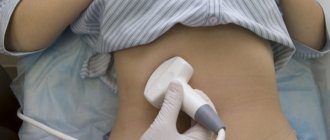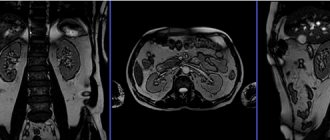Kidney ultrasound technique
A kidney test is performed with a full bladder. This is necessary in order to artificially create fullness of the ureters and functional structures of the kidneys. Under these conditions, the best visualization is achieved.
The study is carried out exclusively on an empty stomach, so it is important not to take any food at least 12 hours before the procedure.
For 1-2 days before the test, you need to adhere to a special diet that excludes foods that cause excessive fermentation and gas formation in the body. You need to remove kefir, yogurt, legumes, sauerkraut, carbonated drinks, and black bread from your diet.
The study is carried out in the morning; an hour before it starts, you need to drink at least 1 liter of water and, accordingly, not urinate.
Preparing for an ultrasound of the kidneys
For three days before the test, you must adhere to a special diet that helps reduce the occurrence of gases in the intestines. You should not eat alcoholic and carbonated drinks, sweets, fatty foods, fried, smoked foods, legumes, cabbage, or milk. Preference should be given to lean types of meat, boiled or steamed, porridges, and boiled fish. You can include low-fat cheese in your diet. In addition, between meals you can take enterosorbents (for example, activated carbon) or defoamers (for example, Espumisan). During meals, it is also recommended to drink a Mezima tablet or similar enzyme preparations.
If the patient suffers from constipation, it is also recommended to take a laxative or do a cleansing enema on the eve of the test.
Is it possible to eat?
Eating before a kidney ultrasound
possible no later than 8-12 hours in advance, due to the fact that the procedure is carried out on an empty stomach.
Should you drink water?
About an hour before the diagnosis, you need to drink several glasses of plain water or tea without sugar, and you should not urinate after this.
How is a kidney ultrasound performed in the clinic?
Diagnostics in our clinic are carried out in a specialized room equipped with modern equipment using completely sterile instruments. The procedure itself lasts no more than 20 minutes, the duration will depend on the patient’s individual parameters.
The examination process occurs as follows:
- The patient undresses to the waist and takes a horizontal position on a specially prepared couch.
- The skin at the site of the organ being examined is covered with a gel, the basis of which is aqueous components that cannot cause allergies. Applying the gel is a mandatory procedure, which is designed to fill the air gap between the sensor and the skin in order to better penetrate sound waves into the tissue.
- The main part of the study involves driving a special sensor over the surface of the skin. Ultrasound waves are reflected from the organ being examined and transmit the results to the monitor screen.
- During the procedure, you may need to hold your breath several times for short periods of time.
The duration of the kidney ultrasound does not affect the final results. In our clinic, such diagnostic procedures are performed in the morning, which makes it possible to exclude food intake. If the examination is scheduled for the afternoon, a light breakfast is allowed. In cases where the patient has certain contraindications to the procedure, the doctor should be notified of their presence.
Kidney ultrasound at home
Not all patients have the opportunity to visit the clinic on their own. In such situations, kidney diagnostics is provided through ultrasound at home . The examination will be carried out in a comfortable home environment based on the patient’s social status and taking into account the characteristics of the place of residence.
This method allows you to significantly save time and will be useful to the following categories of people:
- patients limited in independent movement due to their physical capabilities;
- older people who have difficulty moving independently, especially on public transport;
- patients undergoing a rehabilitation period after surgery;
- people who have a limited amount of time due to being very busy.
Often, patients who experience ailments caused by kidney problems postpone visiting the clinic until the last moment. This attitude towards one’s own health contributes to the development of chronic forms of diseases and subsequent serious complications that can cause significant damage to a specific organ and the body as a whole.
If you have characteristic symptoms indicating the need for a kidney ultrasound, you can use the diagnostic service at home, avoiding a personal visit to the clinic and standing in line.
Indications for ultrasound of the kidneys
An ultrasound of the kidneys is recommended for the following symptoms:
- pain of any kind in the lumbar region;
- frequent episodes of increased blood pressure that cannot be associated with diseases of the cardiovascular system;
- urination disorders (too frequent, infrequent, unbearable urge to urinate, mainly night urge, etc.);
- painful urination (pain may occur before, during, or after urination);
- after urination there is a feeling of incomplete emptying of the bladder;
- changes in the characteristics of urine (normally there should be no change in its color, smell, or the appearance of traces of blood, mucus, or pus in it);
- change in the volume of urine excreted;
- injuries to the back and abdomen, in which there is a high probability of kidney damage;
- swelling of the face and body, not associated with the consumption of excess fluid.
Kidney ultrasound is included in the list of procedures that can be prescribed without the presence of pathological symptoms. Thus, an ultrasound of the kidneys during pregnancy should be performed for the purpose of early detection of a number of pathologies, since during this period the load on the urinary system increases. An ultrasound of the kidneys of a child in the first year of life is recommended to identify congenital anomalies in the structure of organs and the urinary tract, which can exist asymptomatically for a long time.
Another indication for an ultrasound scan of the kidneys is undergoing a course of treatment for identified pathologies of the urinary system. In this case, the study allows you to observe the dynamics of changes in the condition of organs, evaluate the effectiveness of therapy and timely adjust treatment tactics.
How to prepare for a kidney ultrasound
Proper preparation for the ultrasound examination procedure affects the accuracy and information content of the final results. Therefore, it is quite important to follow all the recommendations received.
A few days before the planned study, exclude foods that increase gas formation from your diet. These include potatoes, sweet confectionery, rye bread, milk and raw vegetables. Following a simple diet promotes the normal passage of ultrasonic waves. Gases or excess air in the intestines create a certain barrier that can distort the results.
On the eve of the examination, you should refrain from eating large amounts of food and limit yourself to a light dinner. When conducting diagnostics, it is advisable to take a towel with you to lay on the couch and wet wipes to remove the gel upon completion of the procedure.
Ultrasound of the kidneys: why is it done and how to prepare correctly?
Kidneys are organs of the excretory system that finally filter out harmful and unnecessary substances from the body, maintain water balance and form urine. If there is any suspicion of poor kidney function, the doctor prescribes ultrasound diagnostics in order to identify or exclude pathologies, diseases of the urinary system, and various types of formations.
When performing an ultrasound of the abdominal organs
Difficulties may always arise due to the accumulation of gases in the intestines. Therefore, preparation for an ultrasound of the abdominal cavity and kidneys involves a special diet. You may need to take certain medications.
Which doctor performs kidney ultrasound?
The procedure for examining internal organs, including the kidneys, using ultrasound is performed by an ultrasound specialist. During the event, a picture with the outlines of the kidneys is displayed on the monitor.
This diagnostic method is extremely accurate and completely safe for the patient. Thanks to the informative results, the doctor is given the opportunity to make the correct diagnosis and select the most effective treatment method.
The responsibilities of an ultrasound specialist include complete control over the course of the procedure and all necessary manipulations. To effectively perform the assigned tasks, the doctor must understand the transmitted image on the screen and competently draw up reporting documentation of what he saw, reflecting this in the patient’s card.
To correctly perform all actions, the specialist in our clinic has the appropriate knowledge of topographic anatomy:
- maximum norms for kidney size;
- characteristic signs of pathological abnormalities;
- the natural structure of all tissue connections of the examined organ;
- kidney size, in the presence of certain diseases.
Upon completion of the examination, a final diagnosis will be made, which is formed on the basis of decrypted data from the monitor screen. If an ultrasound scan reveals symptoms indicating a specific disease, it is recorded in the patient’s chart.
Answers to frequently asked questions:
- How to prepare for an appointment with a urologist?
- How to get tested for urological diseases?
- What tests can be done by a urologist?
- What diseases does a urologist treat?
- What symptoms should you consult a urologist for?
- What diagnostics can a urologist perform in your clinic?
- How to call a urologist at home?
- What urological equipment does your clinic have?
- Urological care in the clinic
- Urological care at home
- How to make an appointment with a urologist at the clinic?
Preparation for the procedure
If you are scheduled for a kidney ultrasound, preparation for the study includes the following measures:
- Avoid foods that increase gas formation in the intestines. 3-4 days before the upcoming test, you need to exclude legumes, raw vegetables and fruits, baked goods, rye bread, whole milk products, and carbonated drinks from your diet;
- two hours before the kidney ultrasound, drink 3-4 glasses of water. This will help to obtain more accurate results, since ultrasonic waves diverge better in an aquatic environment.
If you are prone to constipation or flatulence, be sure to inform the doctor who prescribes the ultrasound. The accumulation of stool and gases in the intestines can make it difficult to carry out ultrasound to the kidneys. Therefore, preparation for an ultrasound of the kidneys may include performing a cleansing enema, taking laxatives, carminatives, and enterosorbents. Specific medications, their dosage and method of administration are prescribed by the doctor. The doctor will additionally tell you how to prepare for an ultrasound of the kidneys in special situations (examination of a newborn child, a patient in the postoperative period, etc.).
Preparing for a kidney ultrasound in women during pregnancy beyond 12 weeks does not require any special measures. It is enough to limit the consumption of foods that increase gas formation in the intestines.
Normal kidney size on ultrasound
Upon completion of the procedure, the patient is given a form in which all the results of the ultrasound examination are indicated. Further interpretation will be carried out by the attending physician. When assessing kidney parameters, the size and structure of the organ are first taken into account. Most pathologies are accompanied by a significant increase in the size of tissue joints.
Indicators of normal kidneys will vary based on the age and individual characteristics of each patient. For an adult, the following are considered satisfactory indicators:
- thickness from 45 to 50 mm;
- parenchyma thickness from 13 to 23 mm;
- length from 100 to 120 mm;
- width from 50 to 60 mm.
In children, healthy kidneys look a little different. The normal thickness is considered to be within 40mm, width from 23 to 25mm, length from 46 to 63mm, and the thickness of the parenchyma should not exceed 18mm.
What diseases are detected on a kidney ultrasound?
According to statistics, most kidney diseases are detected through an ultrasound procedure. Based on the results of the data obtained, the attending physician conducts a full analysis of the condition of the kidneys and urinary system, assessing their correct location in relation to other organs.
Thus, kidney ultrasound allows you to diagnose the following diseases:
- hydronephrosis;
- pathological abnormalities in the structure of the kidneys;
- inflammatory processes in the bladder;
- the presence of neoplasms of varying degrees;
- the presence of sand and kidney stones;
- vascular diseases.
Also, during diagnostic measures, the stage at which the inflammatory process is located and the possible manifestation of cell necrosis is revealed. Based on the severity of organ dysfunction, additional studies may be prescribed to confirm existing results.









